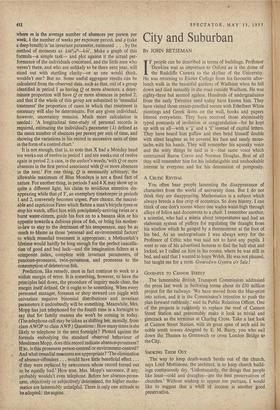City and Suburban BY JOHN BETJEMAN I F people can be
described in terms of buildings, Professor Dawkins was as important to Oxford as is the dome of the Radcliffe Camera to the skyline of the University. He was returning to Exeter College from his favourite after- lunch walk in the beautiful gardens of Wadham when he fell down and died instantly in the road outside Wadham. He was eighty-three but seemed ageless. Hundreds of undergraduates from the early Twenties until today have known him. They have visited those cream-panelled rooms with Ethelbert White paintings and Greek ikons on the wall, books and papers littered everywhere. They have received those abominably typed postcards of invitation or congratulation—for he kept up with us all—with a 'I' and a 1' instead of capital letters. They have heard him guffaw and then bend himself double with silent laughter as he covered his face and sandy mous- tache., with his hands. They will remember his squeaky voice and the witty things he said in it—that same voice which entertained Baron Corvo and Norman Douglas. Best of all they will remember him for his indefatigable and unshockable interest in everyone and for his detestation of pomposity.
A CELTIC REVIVAL You often hear people lamenting the disappearance of characters from the world of university dons. But I do not think they are disappearing. Mathematics is a subject which always breeds a fine crop of eccentrics. So does history. I can think of one don's rooms where one wades waist-high through alleys of folios and documents to a chair. I remember another, a scientist, who had a mania about temperatures and had an elaborate system of pulleys for regulating the draught from his window which he gauged by a thermometer at the foot of his bed. As an undergraduate I was always sorry for the Professor of Celtic who was said not to have any pupils. I went to one of his advertised lectures to find the hall shut and locked, so Leaned on him in his rooms, where he was still in bed, and said that I wanted to learn Welsh. He was not pleased, but taught me for a term. Gwaredwn Gymru o'r Sais !
GOOD-BYE TO CANNON STREET
The lamentable British Transport Commission addressed the press last week in hectoring terms about its £50 million project for the railways. 'We have moved from the blue-print into action, and it is the Commission's intention to push the plan forward ruthlessly,' said its Public Relations Officer. One of the projects is ruthlessly to replace the roof of Cannon Street Station and presumably make it look as trivial and gimcrack as the terminus at Charing Cross. Take a last look at Cannon Street Station, with its great span of arch and its noble south towers designed by E. M. Barry, you who sail down the Thames to Greenwich or cross London Bridge to the City.
SMOKING THEM OUT
The way to keep death-watch beetle out of the church, says Lord Mottistone, the architect, is to keep church build- ings continuously dry. 'Unfortunately, the things that people like least—cold and draughts—are the best preservatives of churches.' Without wishing to appear too partisan, I would like to suggest that a whiff of incense is another good preservative.


































 Previous page
Previous page